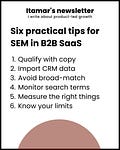Six practical tips for SEM in B2B SaaS
There’s a misconception that SEM is simple.
It is perhaps somewhat true when considering eCommerce or services, but it’s not true for B2B.
B2B companies have long sales cycles, work in multiple verticals, and have tiny search volumes. All this creates unique challenges for doing SEM.
Here are some tips for overcoming those:
1. Qualify with copy
You’re not selling shoes. You’re selling a complex product, which means that it’s not relevant to everyone.
Most likely, there are only several verticals where you genuinely have a product market fit: Financial institutions, medium-sized businesses, companies that work with Salesforce, etc.
Mention those qualifications in your copy. Doing so will attract the right users and prevent irrelevant users from clicking on the ad and wasting your budget.
2. Import CRM data to Google Ads
It is simply too easy to generate signups. You can generate dozens of those without them ever going on a sales call and becoming a paying customer.
This is why you must always track deep funnel conversions (such as conversion to paid or meeting status) within your Google Ads account to understand which of your campaigns actually generate paying customers.
3. Avoid broad match keywords
Google Ads reps will always recommend broad keywords. Ignore them. Broad-match keywords will waste your budget on completely irrelevant phrases.
Are you targeting the keyword ITSM hoping to reach CIOs in Fortune 500 companies? If you use broad-match, your ads will also appear when someone searches for “salary it job.”
Always stay with exact match keywords.
4. Monitor search terms frequently
Even if you use exact match, Google might still let some (or a lot) of irrelevant phrases in. Monitor your search terms frequently and exclude those.
5. Measure the right things
If you optimize your ads for CTR (number of clicks/number of impressions), you are at risk of sacrificing your CVR (number of conversions/number of clicks). If you optimize for CVR, you are at risk of sacrificing your CTR.
This is why you should optimize your ads for conversion from impression to conversion (number of conversions/number of impressions.) This way, you optimize both CTR and CVR at the same time.
6. Know your limits
SEM works well when you want to tap into existing demand for your product category. But it is also limited by this demand.
There’s always a point with SEM where you cannot scale further. You can double your budget but still generate the same results.
Know when you get to this point.




